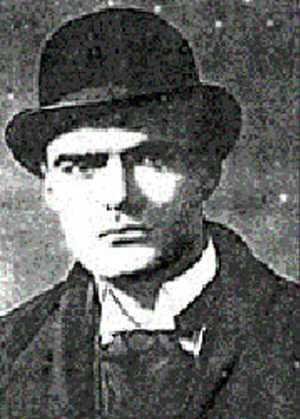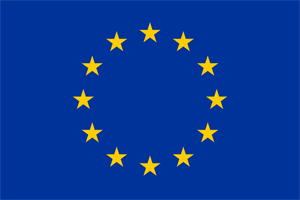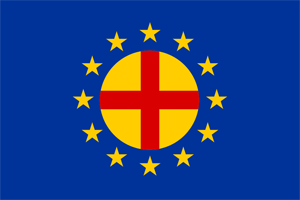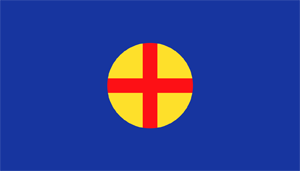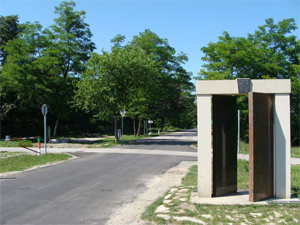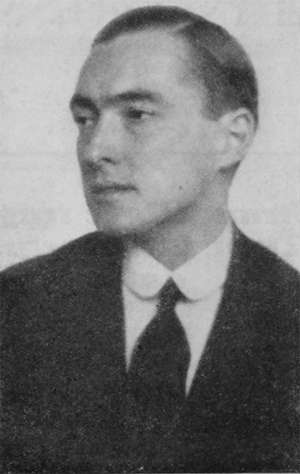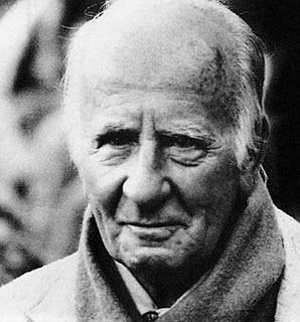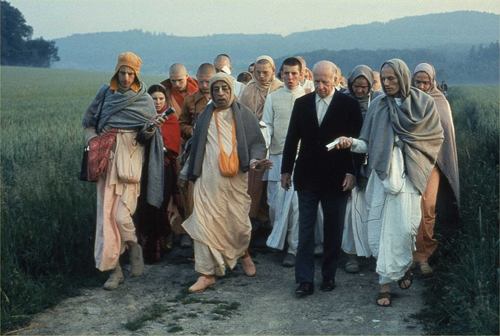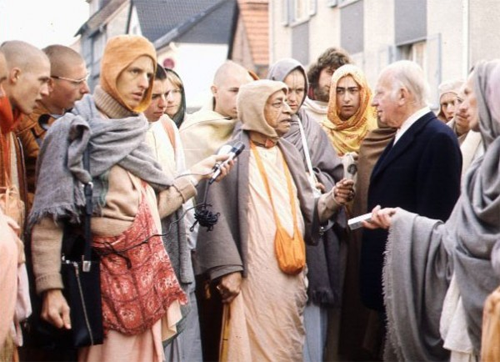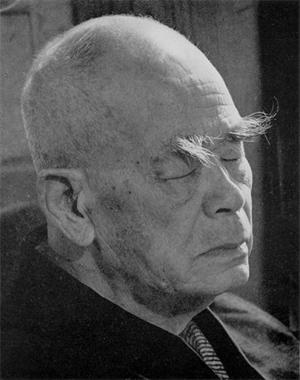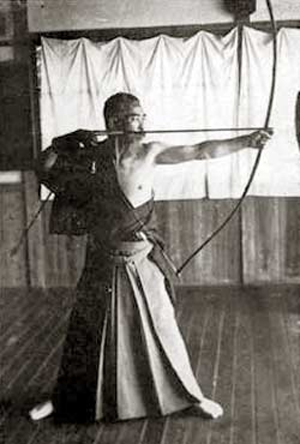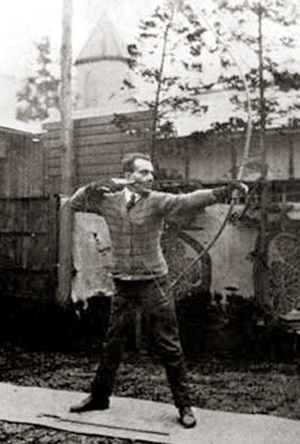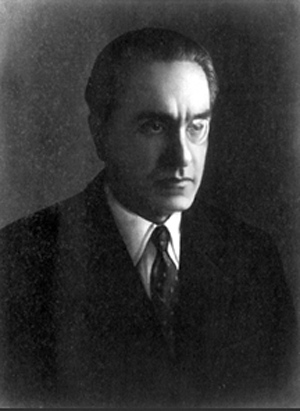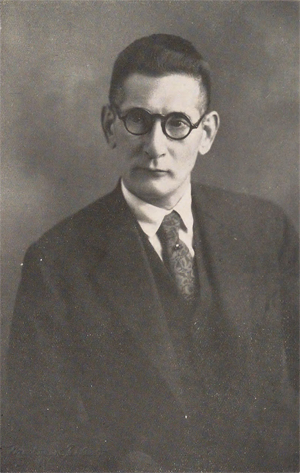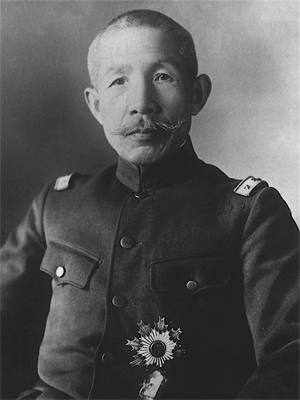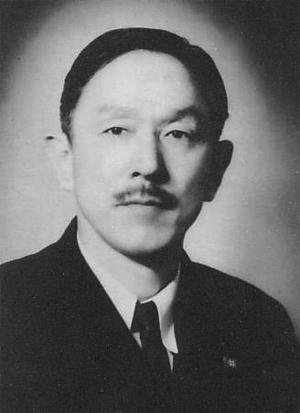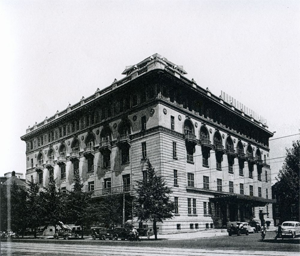Part 2 of 2
Views on JewsEvola endorsed Otto Weininger's views on the Jews. Though Evola viewed Jews as corrosive and anti-traditional, he described Adolf Hitler's more fanatical anti-Semitism as a paranoid idée fixe that damaged the reputation of the Third Reich.[14] Evola's conception did not emphasize the Nazi racial conception of Jews as "representatives of a biological race"—in Evola's view the Jews were "the carriers of a world view ... a spirit [that] corresponded to the 'worst' and 'most decadent' features of modernity: democracy, egalitarianism and materialism."[12]
Evola argued that The Protocols of the Elders of Zion—whether or not a forgery—accurately reflect the conditions of modernity.[31][14] He believed that the Protocols "contain the plan for an occult war, whose objective is the utter destruction, in the non-Jewish peoples, of all tradition, class, aristocracy, and hierarchy, and of all moral, religious, and spiritual values."[58] He wrote the foreword to the second Italian edition of the Protocols, which was published by the Fascist Giovanni Preziosi in 1938.[58][59]
Following the murder of his friend Corneliu Zelea Codreanu, the leader of the Fascist Romanian Iron Guard, Evola expressed anticipation of a "talmudic, Israelite tyranny."[14][page needed] However, Evola believed that Jews had this "power" only because of European "decadence" in modernity.[8] He also believed that one could be "Aryan", but have a "Jewish" soul, just as one could be "Jewish", but have an "Aryan" soul.[60] In Evola's view, Otto Weininger and Carlo Michelstaedter were Jews of "sufficiently heroic, ascetic, and sacral" character to fit the latter category.[29]:105
FascismEvola developed a line of argument, closely related to the spiritual orientation of Traditionalist writers such as
René Guénon and the political concerns of the European Authoritarian Right.[6] Evola's first published political work was an anti-fascist piece in 1925. In this work, Evola called Italy's fascist movement a "laughable revolution," based on empty sentiment and materialistic concerns. He applauded Mussolini's anti-bourgeois orientation and his goal of making Italian citizens into hardened warriors, but criticized Fascist populism, party politics, and elements of leftism that he saw in the fascist regime. Evola saw Mussolini's Fascist Party as possessing no cultural or spiritual foundation. He was passionate about infusing it with these elements in order to make it suitable for his ideal conception of Übermensch culture which, in Evola's view, characterized the imperial grandeur of pre-Christian Europe.[7][page needed] He expressed anti-nationalist sentiment, stating that to become "truly human," one would have to "overcome brotherly contamination" and "purge oneself" of the feeling that one is united with others "because of blood, affections, country or human destiny." He also opposed the futurism that Italian fascism was aligned with, along with the "plebeian" nature of the movement.[29]:86 Accordingly, Evola launched the journal La Torre (The Tower), to voice his concerns and advocate for a more elitist fascism.[10] Evola's ideas were poorly received by the fascist mainstream as it stood at the time of his writing.[30]
Mussolini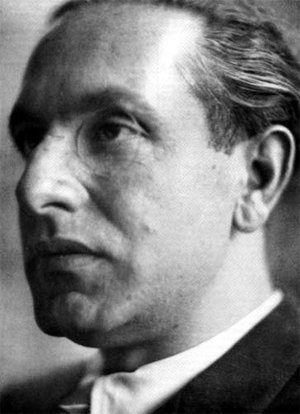 Julius Evola (1940)
Julius Evola (1940)Scholars disagree about why Benito Mussolini embraced racist ideology in 1938—some scholars have written that Mussolini was more motivated by political considerations than ideology when he introduced anti-semitic legislation in Italy.[61] Other scholars have rejected the argument that the racial ideology of Italian fascism could be attributed solely to Nazi influence.[62] A more recent interpretation is that Mussolini was frustrated by the slow pace of fascist transformation and, by 1938, had adopted increasingly radical measures including a racial ideology. Aaron Gillette has written that "Racism would become the key driving force behind the creation of the new fascist man, the uomo fascista."[63]
Mussolini read Evola's Synthesis of the Doctrine of Race in August 1941, and met with Evola to offer him his praise. Evola later recounted that Mussolini had found in his work a uniquely Roman form of Fascist racism distinct from that found in Nazi Germany. With Mussolini's backing, Evola launched the minor journal Sangue e Spirito (Blood and Spirit). While not always in agreement with German racial theorists, Evola traveled to Germany in February 1942 and obtained support for German collaboration on Sangue e Spirito from "key figures in the German racial hierarchy."[10] Fascists appreciated the palingenetic value of Evola's "proof" "that the true representatives of the state and the culture of ancient Rome were people of the Nordic race."[10] Evola eventually became Italy's leading racial philosopher.[13]
Evola blended Sorelianism with Mussolini's eugenics agenda. Evola has written that "The theory of the Aryo-Roman race and its corresponding myth could integrate the Roman idea proposed, in general, by fascism, as well as give a foundation to Mussolini's plan to use his state as a means to elevate the average Italian and to enucleate in him a new man."[64]
In May, 1951, Evola was arrested and charged with promoting the revival of the Fascist Party, and of glorifying Fascism. Defending himself at trial, Evola stated that his work belonged to a long tradition of anti-democratic writers who certainly could be linked to fascism—at least fascism interpreted according to certain Evolian criteria—but who certainly could not be identified with the Fascist regime under Mussolini. Evola then declared that he was not a Fascist but a "superfascist". He was acquitted.[12]
Third ReichFinding Italian fascism too compromising, Evola began to seek recognition in Nazi Germany. Evola spent a considerable amount of time in Germany in 1937 and 1938, and gave a series of lectures to the German–Italian Society in 1938.[10] Evola took issue with Nazi populism and biological materialism. SS authorities initially rejected Evola's ideas as supranational and aristocratic though he was better received by members of the conservative revolutionary movement.[14] The Nazi Ahnenerbe reported that many considered his ideas to be pure "fantasy" which ignored "historical facts.".[10] Evola admired Heinrich Himmler, whom he knew personally,[10] but he had reservations about Adolf Hitler because of Hitler's reliance on völkisch nationalism.[8] Himmler's Schutzstaffel ("SS") kept a dossier on Evola—dossier document AR-126 described his plans for a "Roman-Germanic Imperium" as "utopian" and described him as a "reactionary Roman," whose goal was an "insurrection of the old aristocracy against the modern world." The document recommended that the SS "stop his effectiveness in Germany" and provide him with no support, particularly because of his desire to create a "secret international order".[8][65][66]
Despite this opposition, Evola was able to establish political connections with pan-Europeanist elements inside the Reich Main Security Office.[8] Evola subsequently ascended to the inner circles of Nazism as the influence of pan-European advocates overtook that of Völkisch proponents, due to military contingencies.[8] Evola wrote the article Reich and Imperium as Elements in the New European Order for the Nazi-backed journal European Review.[8] He spent World War II working for the Sicherheitsdienst.[8] The Sicherheitsdienst bureau Amt VII, a Reich Main Security Office research library, helped Evola acquire arcane occult and Masonic texts.[67][32][8]
Italian Fascism went into decline when, in 1943, Mussolini was deposed and imprisoned. At this point, Evola fled to Germany with the help of the Sicherheitsdienst.[8] Although not a member of the National Fascist Party, and despite his apparent problems with the Fascist regime, Evola was one of the first people to greet Mussolini when the latter was broken out of prison by Otto Skorzeny in September, 1943.[68] Subsequently, Evola helped welcome Mussolini to Adolf Hitler's Wolf's Lair.[8] Following this, Evola involved himself in Mussolini's Italian Social Republic.[14] It was Evola's custom to walk around the city of Vienna during bombing raids in order to better "ponder his destiny". During one such raid, 1945, a shell fragment damaged his spinal cord and he became paralyzed from the waist down, remaining so for the rest of his life.[69]
Post-War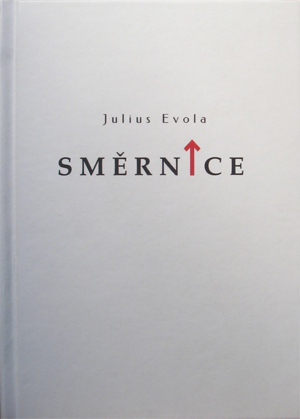 Julius Evola – Směrnice (2015), the Czech translation of his book Orientamenti (1950).
Julius Evola – Směrnice (2015), the Czech translation of his book Orientamenti (1950).After World War II, Evola continued his work in esotericism. He wrote a number of books and articles on sex magic and various other esoteric studies, including The Yoga of Power: Tantra, Shakti, and the Secret Way (1949), Eros and the Mysteries of Love: The Metaphysics of Sex (1958), and Meditations on the Peaks: Mountain Climbing as Metaphor for the Spiritual Quest (1974). He also wrote his two explicitly political books Men Among the Ruins: Post-War Reflections of a Radical Traditionalist (1953), Ride the Tiger: A Survival Manual for the Aristocrats of the Soul (1961), and his autobiography,[8] The Path of Cinnabar (1963). He also expanded upon critiques of American civilization and materialism, as well as increasing American influence in Europe, collected in the posthumous anthology Civiltà Americana.[70]
Evola's occult ontology exerted influence over post-war neo-fascism.[10] In the post-war period, Evola's writing evoked interest among the neo-fascist right.[12] After 1945, Evola was considered the most important Italian theoretician of the conservative revolutionary movement[12] and the "chief ideologue" of Italy's post-war radical right.[13] According to Egil Asprem and Kennet Granholm, Evola's most significant post-war political texts are Orientamenti and Men Among the Ruins.[71]
Orientamenti was a text against "national fascism"—instead, it advocated for a European Community modeled on the principles of the Waffen-SS.[8] The Italian Neo-fascist group Ordine Nuovo adopted Orientamenti as a guide for action in postwar Italy.[72] The European Liberation Front, who were affiliated with Francis Parker Yockey, called Evola "Italy's gretest living authoritarian philosopher" in the April 1951 issue of their publication Frontfighter.[8]
During the post-war period, Evola attempted to dissociate himself from totalitarianism, preferring the concept of the "organic" state, which he put forth in his text Men Among the Ruins.[6] Evola sought to develop a strategy for the implementation of a "conservative revolution" in post World War II Europe.[6] He rejected nationalism, advocating instead for a European Imperium, which could take various forms according to local conditions, but should be "organic, hierarchical, anti-democratic, and anti-individual."[6] Evola endorsed Francis Parker Yockey's neo-fascist manifesto Imperium, but disagreed with it because he believed that Yockey had a "superficial" understanding of what was immediately possible.[8] Evola believed that his conception of neo-fascist Europe could best be implemented by an elite of "superior" men who operated outside normal politics.[8]
Giuliano Salierni was an activist in the neo-Fascist Italian Social Movement during the early 1950s. He later recalled Evola's calls to violence.[14] Roberto Fiore and his colleagues in the early 1980s helped the National Front's "Political Soldiers" forge a militant elitist philosophy based on Evola's "most militant tract", The Aryan Doctrine of Battle and Victory. The Aryan Doctrine called for a "Great Holy War" that would be fought for spiritual renewal and fought in parallel to the physical "Little Holy War" against perceived enemies.[14] Wolff attributes extreme-right terrorist actions in Italy in the 1970s and 1980s to the influence of Julius Evola.[12]
Thomas Sheehan has argued that Evola's work is essential reading for those seeking to understand Eurofascism, in the same way that knowledge of the writings of Karl Marx is necessary for those seeking to understand Communist actions.[43]
Political influenceThe Italian Fascist leader Benito Mussolini, the Nazi Grail seeker Otto Rahn, and the Romanian fascist sympathizer and religious historian Mircea Eliade admired Julius Evola.[16][67][12][8] After World War II, Evola's writings continued to influence many European far-right political, racist and neo-fascist movements. He is widely translated in French, Spanish, partly in German, and mostly in Hungarian (the largest number of his translated works).[73] Amongst those he has influenced are the American Blackshirts Party, the "esoteric Hitlerist" Miguel Serrano,[8] Savitri Devi, GRECE, the Movimento sociale italiano (MSI), Gaston Armand Amaudruz's Nouvel Ordre Européen, Pino Rauti's Ordine Nuovo, Troy Southgate, Alain de Benoist, Michael Jenkins Moynihan, Giorgio Freda, the Nuclei Armati Rivoluzionari (Armed Revolutionary Nuclei), Eduard Limonov, Forza Nuova, CasaPound Italia, Tricolor Flame and the Conservative People's Party of Estonia.[citation needed] Giorgio Almirante referred to him as "our Marcuse—only better."[43] According to one leader of the neofascist "black terrorist" Ordine Nuovo, "Our work since 1953 has been to transpose Evola's teachings into direct political action."[74] The now defunct French fascist group Troisième Voie was also inspired by Evola.[75] Jonathan Bowden, English political activist and chairman of the far right, spoke highly of Evola and his ideas and gave lectures on his philosophy.
Evola has also influenced the alt-right movement,[16] which also cites Oswald Spengler, H.L Mencken, Sam Francis, and Pat Buchanan as influences.[59] Additionally, Evola has influenced Vladimir Putin advisor[76] Aleksander Dugin.[77][16] The Greek neo-Nazi party Golden Dawn includes his works on its suggested reading list, and the leader of Jobbik, the Hungarian nationalist party, admires Evola and wrote an introduction to his works.[16] Umberto Eco referred to Evola as the "most influential theoretical source of the theories of the new Italian right", and as "one of the most respected fascist gurus".[78]
Donald Trump's former chief adviser Steve Bannon has pointed to Evola's influence on the Eurasianism movement;[79][80] According to Joshua Green's book Devil's Bargain, Evola's Revolt Against the Modern World had initially drawn Bannon's interest to the ideas of the Traditionalist School.[81] Alt-right leader and white nationalist Richard Spencer said that Bannon's awareness of Evola "means a tremendous amount".[16] Some members of the alt-right expressed hope that Bannon might have been open to Evola's ideas, and that through Bannon, Evola's ideas could become influential.[16] According to multiple historians cited by The Atlantic, this is contradictory, as Bannon cited Evola in defense of the "Judeo-Christian west", while Evola hated and opposed Judaism and Jews, Christianity in general, Anglo-Saxon Protestantism specifically, and the culture of the United States.[82] In a leaked email sent by Bannon in March 2016, he told Milo Yiannopoulos, "I do appreciate any piece that mentions Evola."[83]
Books 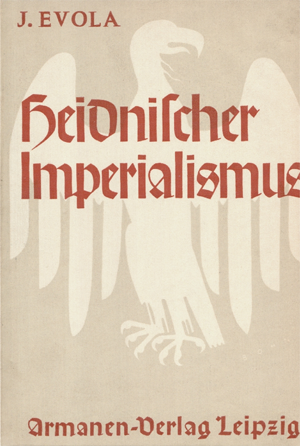 Title page of Heidnischer Imperialismus (1933), the German translation of Julius Evola's book Imperialismo Pagano (1928).
Title page of Heidnischer Imperialismus (1933), the German translation of Julius Evola's book Imperialismo Pagano (1928).• Tao Tê Ching: Il libro della via e della virtù (1923; The Book of the Way and Virtue). Second edition: Il libro del principio e della sua azione (1959; The Book of the Primary Principle and of Its Action).
• Saggi sull'idealismo magico (1925; Essays on Magical Idealism).
• L'individuo e il divenire del mondo (1926; The Individual and the Becoming of the World).
• L'uomo come potenza (1927; Man as Potency).
• Teoria dell'individuo assoluto (1927; The Theory of the Absolute Individual).
• Imperialismo pagano (1928; second edition 1932) ; English translation: Pagan Imperialism. Gornahoor Press. 2017. ISBN 9780999086001.
• Introduzione alla magia (1927–1929; 1971) ; English translation: Introduction to Magic: Rituals and Practical Techniques for the Magus. Inner Traditions/Bear. 2001. ISBN 9780892816248. And: Introduction to Magic, Volume II: The Path of Initiatic Wisdom. Inner Traditions/Bear. 2019. ISBN 9781620557181.
• Fenomenologia dell'individuo assoluto (1930; The Phenomenology of the Absolute Individual).
• La tradizione ermetica (1931); English translation: The Hermetic Tradition: Symbols and Teachings of the Royal Art. Inner Traditions/Bear. 1995. ISBN 9780892814510.
• Maschera e volto dello spiritualismo contemporaneo: Analisi critica delle principali correnti moderne verso il sovrasensibile (1932); English translation: The Mask and Face of Contemporary Spiritualism. Arktos. 2018. ISBN 9781912079346.
• Rivolta contro il mondo moderno (1934; second edition 1951; third edition 1970); English translation: Revolt Against the Modern World: Politics, Religion, and Social Order in the Kali Yuga. Inner Traditions/Bear. 1995. ISBN 9780892815067.
• Tre aspetti del problema ebraico (1936; Three Aspects of the Jewish Problem).
• Il Mistero del Graal e la Tradizione Ghibellina dell'Impero (1937) ; English translation: The Mystery of the Grail: Initiation and Magic in the Quest for the Spirit. Inner Traditions/Bear. 1996. ISBN 9780892815739.
• Il mito del sangue. Genesi del Razzismo (1937; second edition 1942) ; English translation: The Myth of the Blood: The Genesis of Racialism. Arktos. 2018. ISBN 9781912079421.
• Indirizzi per una educazione razziale (1941; The Elements of Racial Education).
• Sintesi di dottrina della razza (1941).
• La dottrina del risveglio (1943) ; English translations: The Doctrine of Awakening: The Attainment of Self-Mastery According to the Earliest Buddhist Texts. Inner Traditions/Bear. 1996. ISBN 9780892815531.
• Lo Yoga della potenza (1949) ; English translation: The Yoga of Power: Tantra, Shakti, and the Secret Way. Inner Traditions/Bear. 1993. ISBN 9780892813681.
• Orientamenti, undici punti (1950) ; English translation: "Orientations: Eleven Points", in A Traditionalist Confronts Fascism. Arktos. 2015. ISBN 9781910524022.
• Gli uomini e le rovine (1953) ; English translation: Men Among the Ruins: Post-War Reflections of a Radical Traditionalist. Inner Traditions/Bear. 2002. ISBN 9780892819058.
• Metafisica del sesso (1958) ; English translations: 1983 - 1991 : Eros and the Mysteries of Love: The Metaphysics of Sex. Inner Traditions/Bear. 1991. ISBN 9780892813155.
• L'operaio nel pensiero di Ernst Jünger (1960).
• Cavalcare la tigre (1961) ; English translation: Ride the Tiger: A Survival Manual for the Aristocrats of the Soul. Inner Traditions/Bear. 2003. ISBN 9780892811250.
• Il cammino del cinabro (1963; second edition 1970); English translation: The Path of Cinnabar. Arktos. 2009. ISBN 9781907166020.
• L'arco e la clava (1968) ; English translation: The Bow and the Club. Arktos. 2018. ISBN 9781912079087.
• Meditazioni delle vette (1974) ; English translation: Meditations on the Peaks: Mountain Climbing as Metaphor for the Spiritual Quest. Inner Traditions/Bear. 1998. ISBN 9781620550380.
• Il fascismo visto valla destra; Note sul terzo Reich (1974) ; English translation: Fascism Viewed from the Right. Arktos. 2013. ISBN 9781907166921. And: Notes on the Third Reich. Arktos. 2013. ISBN 9781907166860.
• Ricognizioni. Uomini e problemi (1974) ; English translation: Recognitions: Studies on Men and Problems from the Perspective of the Right. Arktos. 2017. ISBN 9781912079179.
• Metafisica della Guerra (1996) ; English translation: Metaphysics of War: Battle, Victory and Death in the World of Tradition. Arktos. 2011. ISBN 9781907166365.
See also• José López Rega, also known as Argentine Evola
• Occultism and the far right
• Hans Thomas Hakl
Footnotes1. "Evola cogn.". Dizionario d'ortografia e di pronunzia. Dizionario d'Ortografia e di Pronunzia (DOP). Rai Libri. Retrieved 2018-10-23.
2. Cyprian Blamires. World Fascism: a historical encyclopedia, vol 1. ABC-CLIO, 2006. p. 208.
3. Packer, Jeremy (2009). Secret agents popular icons beyond James Bond. New York: Lang. p. 150.
4. Jump up to:a b Atkins, Stephen E. Encyclopedia of modern worldwide extremists and extremist groups. Greenwood Publishing Group, 2004. p 89.
5. Horrox, James. "Julius Evola". The Literary Encyclopedia. First published 20 July 2011.
6. Paul Furlong, The Social and Political Thought of Julius Evola. London: Routledge, 2011. ISBN 9780203816912
7. Lycourinos, Damon Zacharias, ed. (2012). Occult traditions. Numen Books. ISBN 9780987158130. Retrieved 11 May 2018.
8. Coogan, Kevin (1999). Dreamer of the day : Francis Parker Yockey and the postwar fascist international. Brooklyn, NY: Autonomedia. ISBN 9781570270390. Retrieved 11 May 2018.
9. Franco Ferraresi (2012). Threats to Democracy: The Radical Right in Italy after the War. Princeton University Press. p. 44. ISBN 978-1-4008-2211-9.
10. Gillette, Aaron (2003). "7: Julia Evola and spiritual Nordicism, 1941-1943". Racial Theories in Fascist Italy. Routledge. ISBN 978-1-134-52706-9.
11. Gillette, Aaron (2003-08-29). Racial Theories in Fascist Italy. Routledge. p. 156. ISBN 9781134527069. In particular, Evola had an “almost total adherence” to the principles of the SS and an “almost servile admiration” for Himmler, whom he knew personally; quoting: Raspanti, “Julius Evola fra Salò e Vienna,” pp. 14, 16.
12. Wolff, Elisabetta Cassini. "Evola's interpretation of fascism and moral responsibility", Patterns of Prejudice, Vol. 50, Issue 4–5, 2016. pp. 478–494
13. Payne, Stanley G. (1996). A History of Fascism, 1914–1945. University of Wisconsin Pres. ISBN 978-0-299-14873-7.
14. Goodrick-Clarke, Nicholas (2003). Black Sun: Aryan Cults, Esoteric Nazism, and the Politics of Identity. NYU Press. ISBN 978-0-8147-3155-0.
15. Romm, Jake. "Meet The Philosopher Who's A Favorite Of Steve Bannon And Mussolini". The Forward. Retrieved 23 August 2017.
16. Horowitz, Jason (11 February 2017). "Thinker loved by fascists like Mussolini is on Stephen Bannon's reading list". BostonGlobe.com. New York Times. Retrieved 23 August 2017.
17. Birth records of Rome for the year 1898, National Archives of Rome
18. Birth records of Cinisi for the year 1854, National Archives of Palermo
19. Birth records of Cinisi for the year 1865, National Archives of Palermo
20. Marriage records of Cinisi for the year 1892, National Archives of Palermo
21. Birth records of Rome for the year 1895, National Archives of Rome
22. Il Barone Immaginario, Gianfranco De Turris et al., Ugo Mursia Editore, Milan, 2018
23. Catalogus Baronum, p. 143, number 788.
24. Julius Evola, Il Camino del Cinabro, 1963
25. Roger Griffin, Matthew Feldman. Fascism: Post-war fascisms. Taylor & Francis, 2004. p. 219
26. G.Evola, Il Camino del Cinabro, 1963
27. Evola al processo ai F.A.R.
28. Luca Lo Bianco (1993). "EVOLA, Giulio Cesare Andrea"[Biographical Dictionary of Italians]. Dizionario Biografico degli Italiani (in Italian). 43. Treccani. Retrieved 2018-10-23. Morì a Roma l'11 giugno 1974 e le ceneri, per sua volontà, furono sepolte sul Monte Rosa.
29. Gregor, A. James (2006). The search for neofascism : the use and abuse of social science. Cambridge: Cambridge University Press. ISBN 978-0521676397.
30. Mark Sedgwick. Against the Modern World: Traditionalism and the Secret Intellectual History of the Twentieth Century. Oxford University Press, 2009
31. Richard W. Barber. The Holy Grail: Imagination and Belief. Harvard University Press, 2004
32. T. Skorupski. The Buddhist Forum, Volume 4. Routledge, 2005
33. Harry Oldmeadow. Journeys East: 20th Century Western Encounters with Eastern Religious Traditions. World Wisdom, Inc, 2004. p. 369
34. Donald S. Lopez. Curators of the Buddha: The Study of Buddhism Under Colonialism. University of Chicago Press, 1995. p. 177
35. Arthur Versluis. Magic and Mysticism: An Introduction to Western Esoteric Traditions. Rowman & Littlefield Publishers, 2007. p. 144-145
36. Lennart Svensson. Ernst Junger – A Portrait. Manticore Books, 2016. p. 202
37. Florian Ebeling. The Secret History of Hermes Trismegistus: Hermeticism from Ancient to Modern Times. Cornell University Press, 2007. p. 138
38. Lux in Tenebris: The Visual and the Symbolic in Western Esotericism. BRILL, 2016
39. Glenn Alexander Magee. Hegel and the Hermetic Tradition. Cornell University Press, 2008. p. 200
40. Jump up to:a b Gary Lachman. Politics and the Occult: The Left, the Right, and the Radically Unseen. Quest Books, 2012. p. 215
41. Kathleen Taylor. Sir John Woodroffe, Tantra and Bengal: 'An Indian Soul in a European Body?' . Routledge, 2012. p. 135
42. Richard K. Payne. Tantric Buddhism in East Asia. Simon and Schuster, 2006. p. 229
43. Thomas Sheehan. Italy: Terror on the Right. The New York Review of Books, Volume 27, Number 21 & 22, January 22, 1981
44. Thomas Sheehan. Myth and Violence: The Fascism of Julius Evola and Alain de Benoist. Social Research, XLVIII, 1 (Spring, 1981). 45–73
45. Nevill Drury. The Dictionary of the Esoteric: 3000 Entries on the Mystical and Occult Traditions. Motilal Banarsidass Publ., 2004. p. 96
46. Isotta Poggi. "Alternative Spirituality in Italy." In: James R. Lewis, J. Gordon Melton. Perspectives on the New Age. SUNY Press, 1992. Page 276.
47. Roger Griffin, Matthew Feldman. Fascism: Post-war fascisms. Taylor & Francis, 2004. p. 246
48. Franco Ferraresi. Threats to Democracy: The Radical Right in Italy after the War. Princeton University Press, 2012. p. 220
49. R. Ben-Ghiat, M. Fuller. Italian Colonialism. Springer, 2016. p. 149
50. Annalisa Merelli. "Steve Bannon’s interest in a thinker who inspired fascism exposes the misogyny of the alt-right". Quartz. February 22, 2017
51. J. Gordon Melton, Martin Baumann. Religions of the World: A Comprehensive Encyclopedia of Beliefs and Practices, 2nd Edition [6 volumes]: A Comprehensive Encyclopedia of Beliefs and Practices. ABC-CLIO, 2010. p. 1085
52. Arad, Roy (May 3, 2018). "How an Israeli Bookstore in Berlin Ended Up Accused of Nazi Recruitment". Haaretz. Retrieved July 23, 2018.
53. Conner, Randy P.; Sparks, David Hatfield; Sparks, Mariya (1997). Cassell's Encyclopedia of Queer Myth, Symbol, and Spirit: Gay, Lesbian, Bisexual, and Transgender Lore. Cassell. p. 136.
54. Rota (2008). Intellettuali, dittatura, razzismo di stato. FrancoAngeli. pp. 57–. ISBN 978-88-568-2094-2.
55. Cassata, Francisco (2011). Building the New Man: Eugenics, Racial Science and Genetics in Twentieth-century Italy. Central European University Press. ISBN 9789639776838.
56. Peter H. Merkl. Political Violence and Terror: Motifs and Motivations. University of California Press, 1986. p. 85
57. A. James Gregor, Mussolini's Intellectuals: Fascist Social and Political Thought. Princeton, NJ: Princeton University Press, 2005.
58. Horst Junginger. The Study of Religion Under the Impact of Fascism. BRILL, 2008. p. 136
59. Oren Nimni and Nathan J. Robinson. Alan Dershowitz Takes Anti-Semitism Very Seriously Indeed. Current Affairs. November 16, 2016
60. Gary Lachman. Politics and the Occult: The Left, the Right, and the Radically Unseen. Quest Books, 2012. p. 217
61. See Renzo de Felice, Storia degli ebrei; A. James Gregor; Meir Michaelis, Mussolini and the Jews; contra Aaron Gillette, Racial Theories in Fascist Italy, Ch. 4
62. See Luigi Preti (1968) for discussion of miscegenation; Gene Bernardini (1977) for discussion of German influence
63. Gillette, Racial Theories, p.51-53
64. Gillette, Racial Theories, p.54
65. H.T. Hansen, "A Short Introduction to Julius Evola" in Evola, Revolt Against the Modern World, p xviii.
66. A. James Gregor and Andreas Umland. Erwägen Wissen Ethik, 15: 3 & 4 (2004), pp. 424-429, 591-595; vol. 16: 4 (2005), pp. 566-572 Dugin Not a Fascist?
67. Jump up to:a b Nigel Graddon. Otto Rahn and the Quest for the Grail: The Amazing Life of the Real Indiana Jones. SCB Distributors, 2013
68. Roger Griffin, Matthew Feldman. Fascism: Post-war fascisms. Taylor & Francis, 2004. p. 223
69. Guido Stucco, "Translator's Introduction," in Evola, The Yoga of Power, pp. ix–xv
70. Evola, Julius (2010). Civiltà americana. Scritti sugli Stati Uniti (1930–1968). Napoli: Controcorrente.
71. Egil Asprem, Kennet Granholm. Contemporary Esotericism. Routledge, 2014. p. 245
72. Marlene Laruelle. Eurasianism and the European Far Right: Reshaping the Europe–Russia Relationship. Lexington Books, 2015. p. 102
73.
http://www.tradicio.org/bibliographia.pdf> pp. 130–154]
74. Quoted in Ferraresi, Franco. "The Radical Right in Postwar Italy." Politics & Society. 1988 16:71-119. (p.84)
75. Institute of Race relations. "The far Right in Europe: a guide." Race & Class, 1991, Vol. 32, No. 3:125-146 (p.132).
76. Meyer, Henry and Ant, Onur. "The One Russian Linking Putin, Erdogan and Trump". Bloomberg, February 2017 (subscription required)
77. Marlene Laruelle. Aleksandr Dugin: A Russian Version of the European Radical Right? Woodrow Wilson International Center for Scholars. OCCASIONAL PAPER #294.
78. Eco, Umberto. "Ur-Fascism". The New York Review of Books, Vol. 42, No. 11 (1995), accessed February 12, 2017
79. Feder, J. Lester. "This Is How Steve Bannon Sees The Entire World", BuzzFeed 2016
80. Horowitz, Jason (2017-02-10). "Taboo Italian Thinker Is Enigma to Many, but Not to Bannon". The New York Times. ISSN 0362-4331. Retrieved 2017-02-10.
81. Green, Joshua (2017). Devil's Bargain. Penguin. p. 206.
82. Momigliano, Anna (February 21, 2017). "The Alt-Right's Intellectual Darling Hated Christianity". The Atlantic. Retrieved July 22, 2018.
83. "Here's How Breitbart And Milo Smuggled Nazi and White Nationalist Ideas Into The Mainstream". Buzzfeed. October 5, 2017.
Further readingPublications by and about Julius Evola in the catalogue Helveticat of the Swiss National Library:
• Aprile, Mario (1984), "Julius Evola: An Introduction to His Life and Work," The Scorpion No. 6 (Winter/Spring): 20–21.
• Coletti, Guillermo (1996), "Against the Modern World: An Introduction to the Work of Julius Evola," Ohm Clock No. 4 (Spring): 29–31.
• Coogan, Kevin (1998), Dreamer of the Day: Francis Parker Yockey and the Postwar Fascist International (Brooklyn, NY: Autonomedia, ISBN 1-57027-039-2).
• De Benoist, Alain. "Julius Evola, réactionnaire radical et métaphysicien engagé. Analyse critique de la pensée politique de Julius Evola," Nouvelle Ecole, No. 53–54 (2003), pp. 147–69.
• Drake, Richard H. (1986), "Julius Evola and the Ideological Origins of the Radical Right in Contemporary Italy," in Peter H. Merkl (ed.), Political Violence and Terror: Motifs and Motivations (University of California Press, ISBN 0-520-05605-1) 61–89.
• Drake, Richard H. (1988), "Julius Evola, Radical Fascism and the Lateran Accords," The Catholic Historical Review 74: 403–419.
• Drake, Richard H. (1989), "The Children of the Sun," in The Revolutionary Mystique and Terrorism in Contemporary Italy (Bloomington: Indiana University Press, ISBN 0-253-35019-0), 114–134.
• Faerraresi, Franco (1987), "Julius Evola: Tradition, Reaction, and the Radical Right," European Journal of Sociology 28: 107–151.
• Furlong, Paul (2011). Social and Political Thought of Julius Evola. Taylor & Francis. ISBN 9781136725494.
• Godwin, Joscelyn (1996), Arktos: The Polar Myth in Science, Symbolism, and Nazi Survival (Kempton, IL: Adventures Unlimited Press, ISBN 0-932813-35-6), 57–61.
• Gelli, Frank (2012), Julius Evola: The Sufi of Rome
• Godwin, Joscelyn (2002), "Julius Evola, A Philosopher in the Age of the Titans," TYR: Myth—Culture—Tradition Volume 1 (Atlanta, GA: Ultra Publishing, ISBN 0-9720292-0-6), 127–142.
• Goodrick-Clarke, Nicholas (2001), Black Sun: Aryan Cults, Esoteric Nazism and the Politics of Identity (New York: New York University Press, ISBN 0-585-43467-0, ISBN 0-8147-3124-4, ISBN 0-8147-3155-4), 52–71.
• Griffin, Roger (1985), "Revolts against the Modern World: The Blend of Literary and Historical Fantasy in the Italian New Right," Literature and History 11 (Spring): 101–123.
• Griffin, Roger (1995) (ed.), Fascism (Oxford University Press, ISBN 0-19-289249-5), 317–318.
• Hans Thomas Hakl, "La questione dei rapporti fra Julius Evola e Aleister Crowley", in: Arthos 13, Pontremoli, Centro Studi Evoliani, 2006, p. 269–289.
• Hansen, H. T. (1994), "A Short Introduction to Julius Evola," Theosophical History 5 (January): 11–22; reprinted as introduction to Evola, Revolt Against the Modern World, (Vermont: Inner Traditions, 1995).
• Hansen, H. T. (2002), "Julius Evola's Political Endeavors," introduction to Evola, Men Among the Ruins, (Vermont: Inner Traditions).
• Moynihan, Michael (2003), "Julius Evola's Combat Manuals for a Revolt Against the Modern World," in Richard Metzger (ed.), Book of Lies: The Disinformation Guide to Magick and the Occult (The Disinformation Company, ISBN 0-9713942-7-X) 313–320.
• Rees, Philip (1991), Biographical Dictionary of the Extreme Right Since 1890 (New York: Simon & Schuster, ISBN 0-13-089301-3), 118–120.
• Sedgwick, Mark (2004) Against the Modern World: Traditionalism and the Secret Intellectual History of the Twentieth Century (Oxford University Press, ISBN 0-19-515297-2).
• Sheehan, Thomas (1981) "Myth and Violence: The Fascism of Julius Evola and Alain de Benoist," Social Research, 48 (Spring): 45–83.
• Stucco, Guido (1992), "Translator's Introduction," in Evola, The Yoga of Power (Vermont: Inner Traditions), ix–xv.
• Stucco, Guido (1994), "Introduction," in Evola, The Path of Enlightenment According to the Mithraic Mysteries, Zen: The Religion of the Samurai,
Rene Guenon: A Teacher for Modern Times, and Taoism: The Magic, the Mysticism (Edmonds, WA: Holmes Publishing Group)
• Stucco, Guido (2002). "The Legacy of a European Traditionalist: Julius Evola in Perspective". The Occidental Quarterly 3 (2), pp. 21–44.
• Wasserstrom, Steven M. (1995), "The Lives of Baron Evola," Alphabet City 4 + 5 (December): 84–89.
• Waterfield, Robin (1990), 'Baron Julius Evola and the Hermetic Tradition', Gnosis 14, (Winter): 12–17.
• "Bibliografia di J. Evola". Fondazione Julius Evola. Retrieved 25 April 2015.
